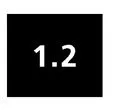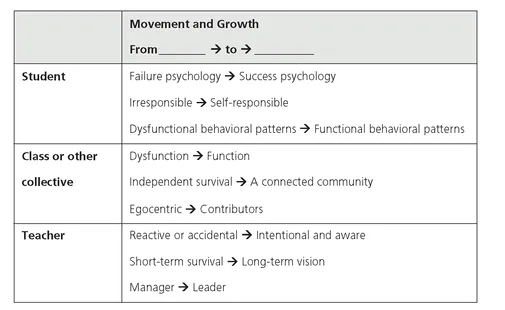![]()
PART 1
Assessing Where We Are and Making Sense of the Inner Workings of the Classroom
![]()
1
Introduction to Transformative Classroom Management
In This Chapter • Introduction
• Transformative classroom management
• Developing a guiding personal vision
• The progression of the book
This book offers strategies to make your classroom a place that changes lives for the better: a transformative classroom. It will demystify the process of creating a high-functioning classroom and will be your guide to creating the kind of class environment that you desire.
CASESTUDY
Ms. L’s Transformative Elementary Class
What first strikes a visitor to Ms. L’s urban public school third-grade class is the low level of anxiety and high level of confidence among the students, which allows them to take risks and express themselves. Today the students return to the classroom after recess and take their seats without any need for direction. After a smooth transition, the class is directed into a math lesson.
In contrast, the third-grade class next door comes back from recess somewhat rowdy and unfocused, and the teacher immediately begins to call out students who are misbehaving. The students finally open their math books after an extended transition. During the lesson, only a few students volunteer to share their ideas because they worry that they will look incompetent, and the teacher interrupts the lesson many times to deal with misbehaving students.
Back in Ms. L’s class, every student appears engaged and eager to share answers and ask questions when they are not clear about the material. The energy in the room is almost entirely focused on the activity, and no students feel the need to entertain themselves or their friends by misbehaving. Ms. L is calm and soft-spoken and refrains from any hint of negativity. She leads the lesson with questions that keep the students engaged and thinking critically, and there is a distinct flow to the activity. Throughout the lesson, the students look forward to being intellectually challenged.
If we had the ability to examine every classroom in every school, we would find that they vary dramatically from one another. We would find classrooms in urban, suburban, rural, public, and private schools, from every grade level and subject area, kindergarten through twelfth grade, that were functional and productive places. In the same sorts of schools, we would also see dysfunctional and unproductive classrooms. If we were to identify the variable in each class that was most responsible for the quality of the learning environment, we would find that it is we ourselves: the teachers. Our thoughts, values, and actions all have the effect of defining the climate and experience in our classes. Too few of us truly appreciate the ultimately powerful influence that we have, and we too often neglect to recognize that our classroom management choices can have a number of important effects:
• Promote community or fragmentation
• Lead to clarity or confusion
• Create a psychology of success or one of failure
• Be a liberating influence or perpetuate an unjust social class structure
• Foster a climate of motivation and joy or one of disinterest and drudgery
Researchers have found that classroom management actions and attitudes can be the difference between teachers having either a sense of job satisfaction and a feeling that their gifts are being successfully used or a feeling of burnout and unhappiness (Friedman & Farber, 1992). Moreover, how teachers approach classroom management will significantly determine the degree to which they feel successful and satisfied with their teaching (Fallona & Richardson, 2006).
READER NOTE
The reflections throughout each chapter offer you opportunities to reflect on the ideas presented in the text in relation to your own experience. They are a means by which you can process the content in the chapter in a practical and personal manner. Some of you may want to skip over the reflections on the first reading, especially if you are attempting to progress through the chapter at a quick pace.
REFLECTION
Survey a sampling of teachers to determine their levels of job satisfaction and levels of stress each day, and include a question about how successful they feel in the area of classroom management. Do you find a relationship between the two?
WHAT IS TRANSFORMATIVE CLASSROOM MANAGEMENT?
To understand what makes a classroom a transformative place, we might begin by examining the four case studies in this chapter. All four teachers have created what could be characterized as transformative classrooms. As you read about each classroom, notice their common attributes: clarity of purpose, self-responsibility, bonds among students, and an increasing level of function over time. In other words, they promote skills that are critical for success both in and outside the classroom.
CASESTUDY
Ms. R’s Transformative High School Social Studies Class
Ms. R teaches social studies in an urban public high school that is considered low performing by most measures: its dropout rate is above 50 percent. But in Ms. R’s class, students are working collaboratively. The students are from different cultures, neighborhoods, and cliques within the school, but in Ms. R’s class, they function as a unified team. When this same group of students was observed the period before, they seemed to be mentally checked out and unruly. In that class, the teacher appeared to struggle with control, spending a lot of time raising his voice and threatening the students about what would happen if they didn’t get to work. In Ms. R’s class, in contrast, the students were entirely invested in the task and prepared when it was time to report their group’s findings. Maybe the best words to describe the class are trusting and respectful. The students respect each other, their teacher, and their learning, and they know that their teacher trusts and respects them.
A transformative classroom functions to change for the better those who are within it—as individuals and as a collective. Transformative classroom management (TCM) is an approach that assumes that classroom management practices have a powerful long-term effect on student development and teachers’ ability to be successful. It presumes that over time, high function is possible in any classroom; that some pedagogical and management practices lead to greater function, while others lead to greater dysfunction; and that if designed successfully, any classroom can be a transformative place.
TCM, unlike many other models, assumes that problems do not require reaction; rather, the sources of those problems need to be identified and altered. Problems within any class should not be viewed, as some would suggest, as a finite quantity of misbehaviors that need to be “dealt with” or “handled.” Both functional and problematic or dysfunctional behaviors have explicable causes and in most cases are related directly or indirectly to teaching practices. Most problems are manifestations of predictable factors, including the interaction between teacher or school and the student, the systems in place, congruence between the expectations of the students and teachers, and the degree to which the class meets the students’ basic needs. TCM places a special emphasis on perpetually working toward a better tomorrow.
REFLECTION
Have you seen classrooms that you would characterize as transformative? Reflect on the kinds of classroom management practices that occurred in them.
Figure 1.1 depicts the three domains of change within the TCM classroom. First, the transformative classroom supports each student’s individual progression from irresponsibility and a “failure psychology” orientation to self-responsibility and a “success psychology” orientation: an internal locus of control, sense of acceptance and belonging, and growth orientation (Ayling, 2009). Second, the transformative classroom promotes the growth of the collective from its current state of function to one of greater function and ultimately into greater levels of community. Third, TCM endeavors to assist teachers in their own growth toward greater levels of self-awareness and a more effective and intentional set of practices, and it provides them the tools to become visionary leaders in the classroom.
DEVELOPING A GUIDING PERSONAL VISION
The process of creating a high-functioning transformative classroom begins by developing a vision of what you want to accomplish. To do so, it will be beneficial to take a few preliminary steps:
1.
Clarify your intention. What do you specifically want? When you reflect on this question, it is useful not to let your thinking be overly restricted by what others tell you is possible,
FIGURE 1.1. The Domains of Transformative Classroom Management
or not possible, or what you have become accustomed to through practice or observation. Allow yourself to conceive a vision that is guided as little as possible by fear and resignation and as much as possible by what you think is right. What kind of classroom would make you proud and would give you a sense of being true to your core values?
2. Be purposeful about raising your level of awareness. If you have not yet started teaching, you might want to observe a broad range of classes in a variety of schools. It is common for teachers to default to practices to which they were exposed themselves, so recognize that what you have seen to this point may have been a limited sample of what is possible. See what is out there. And if you do not see your vision operationalized within the classrooms that you observe, it may mean that you are in the position of making a significant contribution as a trailblazer. If you are currently teaching, this book will offer many opportunities to reflect on what you are doing and why. Exploring both your internal processing as well as your external situation will be useful. More effective practice begins with an examination of who we are and what we value, followed by taking stock of what we are doing and asking ourselves if it is getting us closer to our vision.
3. Recognize that every practice has an effect. Every choice you make shapes the overall classroom climate. Even the smallest action can have a profound impact on the behavior, motivation, and achievement of students.
Stick to Your Vision
Each of us possesses our personal vision of the ideal classroom. For most of us, that vision is rather ambitious and was part of what inspired us to work with young people as teachers, coaches, counselors, administrators, support staff, and paraprofessionals. Yet as we confront the realities of schools over time—the lack of motivation of many students, the discouraging attitudes of some of our peers, the difficulty of the job—many of us increasingly become resigned to relinquishing that ideal vision and make compromises that we never wanted to make out of a perceived need for survival or what seems to be practical necessity. However, what you want to accomplish is possible. You can get there. There are answers and pathways to making your vision a reality.
REFLECTION
Take a moment now or after reading this chapter to envision your ideal classroom. What does it look like? What is going on in it? How do you feel as the teac...






